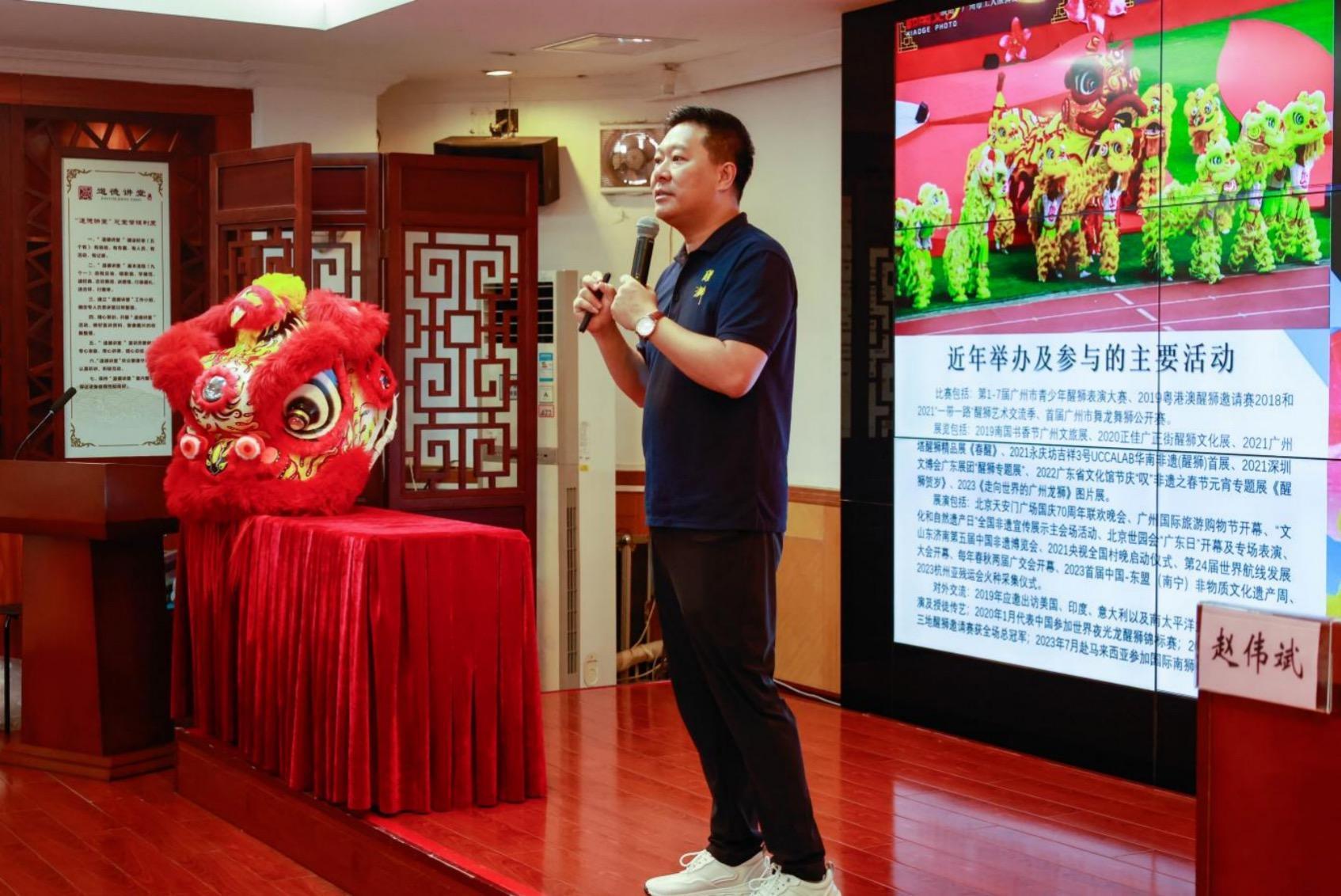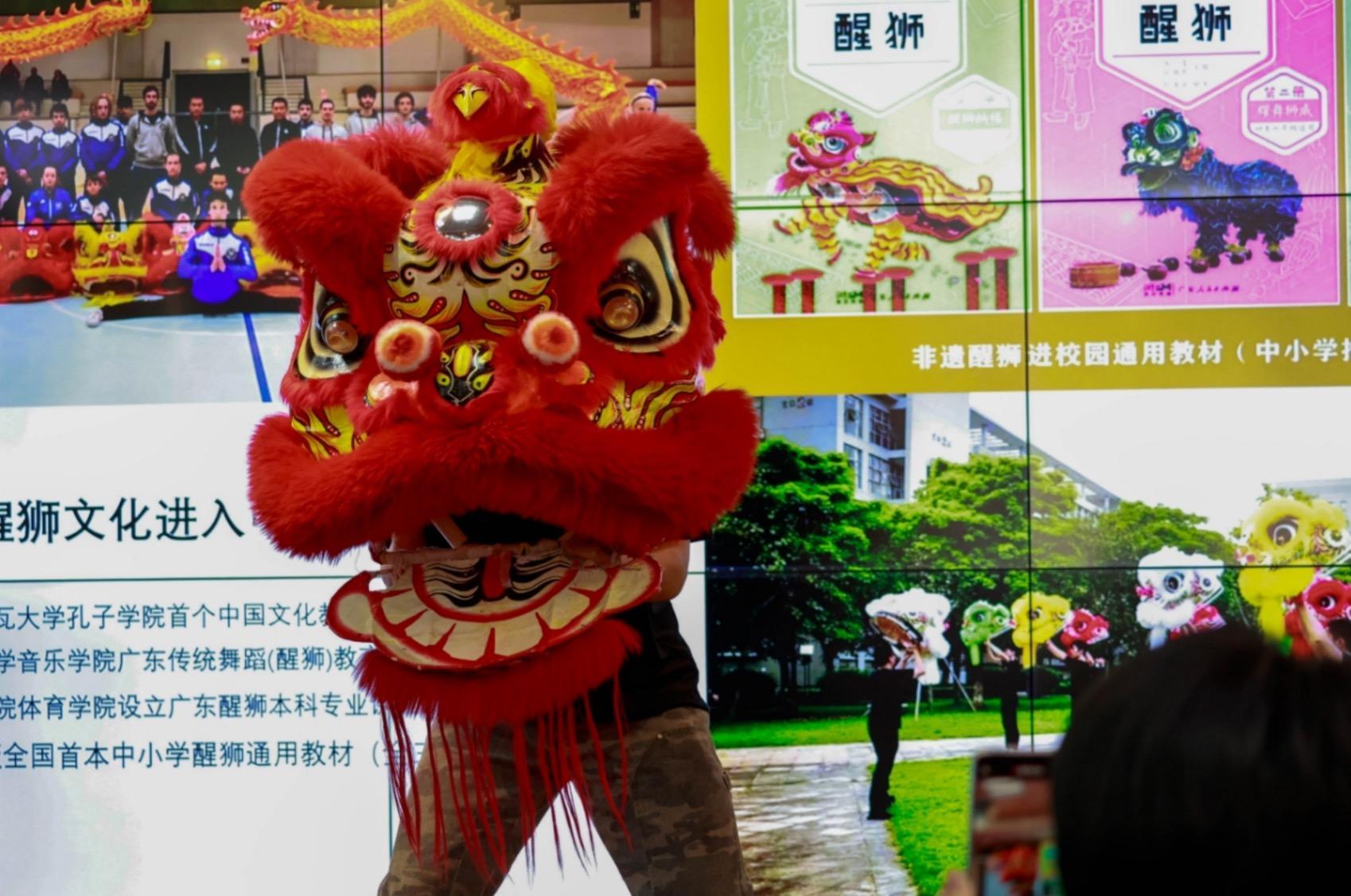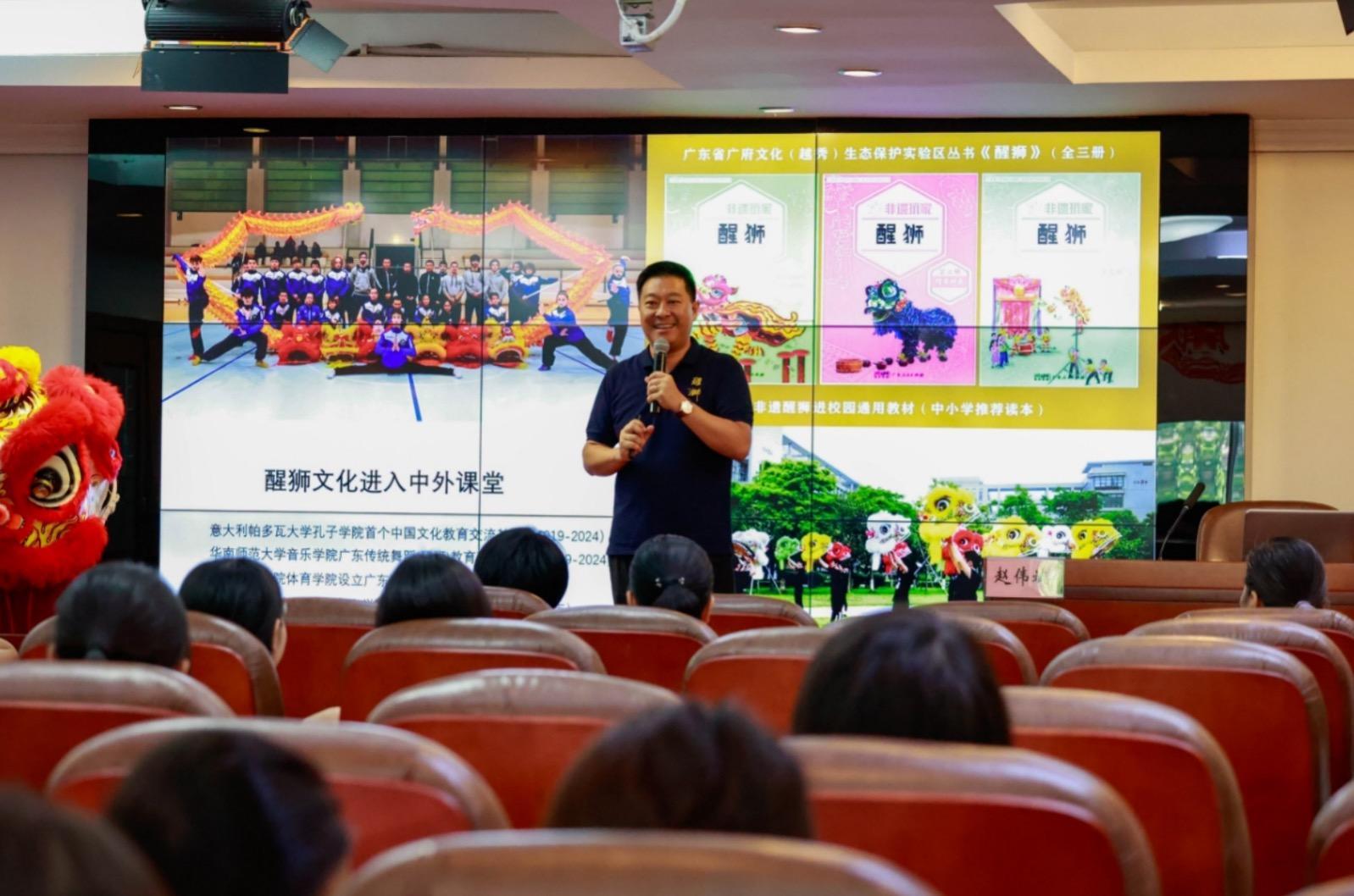
On July 21st, a lecture titled "Inheritance and Promotion of Guangdong Lion Dance" held at Yuexiu Library was given by Zhao Weibin, a provincial representative inheritor of Guangdong lion dance, a national-level intangible cultural heritage, attracting numerous lion dance enthusiasts. Zhao explained that Guangdong lion dance is predominantly popular in cities like Guangzhou, Foshan, and Suixi, and has also spread widely in Chinese Communities in Southeast Asia, serving as a cultural bridge for overseas Chinese to reconnect with their roots. He is committed to presenting the intangible cultural heritage of lion dance through art and technology. Zhao has developed over 100 lion dance cultural and creative products that are highly popular among the public. He served as the lion dance director for the dance drama Awakening Lion, utilized 3D printing for lion heads, designed VR and AR lion dance experiences, and in 2020, launched the world's first lion dance sensory robot.

Zhao Weibin, a native of Guangzhou, is the fifth-generation heir of the "Zhao Heritage Atelier" and the son of "Southern Lion King" Zhao Jihong. For over 40 years, he has maintained a career in lion dance. Zhao has taught and passed on his skills to over ten thousand students both domestically and internationally. He has led the Southern Lion Dance Team on visits to over 30 countries worldwide, promoting Chinese dragon and lion dance culture, exchanging performances, and participating in international lion dance competitions, winning over 100 championships and gold awards.
Zhao explained that the history of Guangdong lion dance can be traced back to Tang Dynasty. After the Five Dynasties and Ten Kingdoms period, as migrants from Central Plains moved southward, lion dance culture spread to Lingnan. During the Ming Dynasty, lion dance became prevalent in Guangdong as an auspicious symbol used to dispel evil and bring good fortune. Over time, it became a fixture in festivals and major events, thriving and passing down through generations.

The movements often feature Southern-style boxing and stances, performing lion movements such as "opening eyes", "shaking the mane", "licking the body", and "shaking off dust". Key routines include "picking the greens", "drinking from the high platform", "spitting out the ball", and "stepping on the poles". Over time, lion dance performances have evolved from traditional ground-based lions to include bench lions, then progressing to high-platform lions, high-pole lions, and pole-mounted lions. The difficulty of pole-mounted lion performances continues to increase, sometimes involving tightrope walking and flying to jump.
In Zhao's view, the "old" aspect of Guangzhou as an ancient city signifies its deep historical roots and rich cultural heritage. On the other hand, the "new" vitality of modern Guangzhou represents continuous renewal, vibrant resilience, and its leading force in setting trends. He believes that the lion dance embodies the joy, liveliness, positivity, agility, bravery, striving for progress, and innovation that characterize the spirit of Guangzhou.

To explore presenting intangible cultural heritage lion dance through art and technology, Zhao has embarked on numerous initiatives. He has developed over 100 popular lion dance cultural and creative products. He served as the lion dance director for the dance drama "Awakening Lion", providing systematic training for actors. He independently created a children's lion dance integrated with hip-hop dance, which was performed 16 times over three occasions at the Shanghai Children's Art Theatre, all sold out. In 2020, he also launched the world's first lion dance sensory robot. This robot not only has a striking lion dance appearance but also achieves millisecond-level responsiveness to its operator. It can perform various drumming and lion dance movements, perfectly recreating scenes of "Lion King Competition".
Source:Lingnan on the Cloud
赵伟斌:以“艺术+”和“科技+”模式传承醒狮非遗
7月21日,由国家级非遗项目广东醒狮省级代表性传承人赵伟斌主讲的讲座《广东醒狮传承与传播》在越秀区图书馆举行,吸引了众多醒狮爱好者。赵伟斌介绍,广东醒狮主要分布在广州、佛山、遂溪等地,在东南亚华侨社区也广为流传,成为海外侨胞认祖归宗的文化桥梁。他致力于在“艺术+”和“科技+”模式下呈现非遗醒狮,开发了深受大众喜爱的100多款醒狮文创产品,担任了舞剧《醒狮》的醒狮指导,还用3D打印狮头,设计了VR醒狮和AR醒狮,并在2020年推出全球首款醒狮体感机器人。
赵伟斌是土生土长的广州人,是“赵家狮”第五代传人、“南狮王”赵继红之子,40多年从未间断过舞狮艺术生涯,在海内外授徒传艺超过一万人,先后带领“南国醒狮”团队出访全球30多个国家推广中国龙狮文化、交流表演和参加国际性龙狮大赛,获冠军和金奖100多项。
赵伟斌介绍,广东醒狮历史上由唐代宫廷狮子舞脱胎而来,五代十国之后,随着中原移民的南迁,舞狮文化传入岭南地区。明代时,醒狮在广东出现,作为驱邪避害的吉祥瑞物,每逢节庆或有重大活动,必有醒狮助兴,长盛不衰,历代相传。
舞狮人动作多以南拳马步为主,狮子动作有“睁眼”“洗须”“舔身”“抖毛”等。主要套路有“采青”“高台饮水”“狮子吐球”“踩梅花桩”等。醒狮在表演上从传统的地狮逐步发展到凳狮,又发展到高台狮、高竿狮、桩狮。桩狮的难度也在不断增大,甚至能完成走钢丝、腾空跳等表演。
在赵伟斌看来,广州老城市的“老”,是悠久的历史沉淀和深厚的文化底蕴;广州新活力的“新”,应该是历久弥新,是一种生机勃勃的韧劲,是一股引领时尚的潮流。他认为,醒狮的喜庆、热闹、阳光、灵巧、勇敢、奋发向上、开拓创新都是广州精神的活写照。
为了探索在“艺术+”和“科技+”模式下呈现非遗醒狮,赵伟斌作了很多尝试,他开发了深受大众喜爱的100多款醒狮文创产品,担任了舞剧《醒狮》的醒狮指导,对演员进行系统训练。他自主创编了剧场版儿童醒狮剧,创造性地将醒狮与嘻哈舞蹈相结合,两年间曾三次在上海儿童艺术剧场连演16场,场场爆满。他还在2020年推出全球首款醒狮体感机器人。机器人不仅有酷炫的醒狮外观形象,更实现了与操作者的毫秒级响应,能做出不同的打鼓和醒狮动作,完美再现“狮王争霸”情形。
文、图|记者 周欣怡 朱绍杰 通讯员 颜群力
译 | 林佳岱
-
Zhao Weibin: inheriting the intangible cultural heritage of lion dance through art and technology
2024-07-24 23:08:08 -
DATA TALK|GDP exceeds 6.5 trillion yuan: Guangdong's economic data for H1 2024 released
2024-07-24 23:16:24 -
On-site visit to the Paris Olympic Village:the current temperature is 22℃, no need for air conditioning
2024-07-24 23:15:46 -
Poster | Chaoshan Yingge Dance encounters Foshan "La Liga" Football League
2024-07-24 21:38:51






